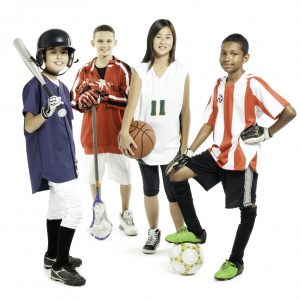Static Vs. Dynamic Stretching
When I was initially tasked to write about stretching, I got excited because as a former athlete and now physical therapist for more than 16 years, I thought I understood the evidence and rationale to easily address this topic. However, like the evidence-informed therapist that I am, I decided to first perform a literature search in order to check my preconceptions. This would prove to be pivotal in how I decided to tackle the subject matter.
What is Static Stretching?
Static stretching is when you take a body part to a point where a “stretch,” or pulling sensation, is felt and hold that position for a length of time, generally less than 60 seconds in duration (position based). An Example of a static stretch for the arm would be a cross body stretch – holding the arm directly across the chest.
What is Dynamic Stretching?
Dynamic Stretching can be classified as a large/gross movement pattern that involves multiple joints and muscles groups moving in and out of various ranges of motion (movement based). An example of a dynamic stretch on the arm would be performing arm circles – moving the arms forward and/or backwards in various degrees of motion.
What are the Benefits of Stretching?
For years it was thought that static stretching prior to activity would help decrease injury, prepare the body for activity, improve range of motion (ROM), and even enhance performance. However, does stretching do any of these things?
- Reduce Injury: Most of the recent data suggests that static stretching alone is inefficient at reducing the likelihood of sustaining an injury with a sporting activity. In fact, depending on the sport, in an article recently reviewed pertaining to golf, adding static stretching seemed to increase in the likelihood of injury. However, if static stretching is incorporated into a comprehensive warm-up program, it may actually help reduce musculotendinous injury in sports that require sprinting/making sharp cuts, i.e., soccer, football, basketball, etc.
- Prepare Body for Activity: The idea of a “warm-up” is to increase blood flow to the muscles that we intend to use for the given activity we are about to perform as well as increase the body’s core body temperature prior to competition. Static stretching alone does not satisfy these goals, which is why many professionals would recommend dynamic stretching.
- Improve ROM: It has been shown that static stretching does increase ROM of the hip and knee with hamstring stretching, but there are very few research studies that have shown the same amount of change in other body areas. To observe these changes in ROM, the static stretch needs to be done consistently for no more than 45 seconds at a time for no fewer than three reps for a minimum of eight weeks.
- Enhance Performance: Initially, I was confident that there was indeed research that supports the notion that static stretching had been shown to reduce strength, power, and muscle performance. While that is not entirely false, the evidence is not as consistent as I had once thought. a 2013 Systematic Review of 104 studies concluded that there was a decrease in strength, power, and explosive performance (to varying degrees). However, when looking at how they did the analysis the individual study designs and the tests they used to measure strength, power, and explosive performance varied greatly, which makes it much more difficult to make blanket statements with regards to performance deficits that may exist after static stretching.
What is the Goal or Purpose of Stretching?
If your goal is to gain range of motion in a specific muscle group or joint, keep the stretch to less than 45 seconds. Dynamic stretching is preferred as it is more efficient and better prepared the body for an activity or sport.
If you want to warm up before an activity, work, or to help reduce injury, consider a Comprehensive Warm-Up (CWU). A CWU should include light aerobic activity (walking, jogging, cycling, jumping rope/jacks, etc. in which you can still speak comfortably), dynamic stretching, and a sport/activity/job specific tasks. For a sport or activity that requires sprinting/quick changes in direction, adding static stretching of less than 45 seconds in a given position may help reduce musculotendinous injury.
Josh Anderson, PT, DPT has over 15 years of diverse experience in both the on-site and outpatient settings treating patients by providing Injury Prevention Services and Early Intervention Screens, as well as utilizing a variety of Physical Therapy techniques to get patients back to work as quickly as possible. His professional interests include Balance and Vestibular Orthopedics, Sports Physical Therapy, and Manual Therapy. Josh is certified in Sports PT through Evidence in Motion, Selective Functional Movement Assessment (SFMA), and Rocktape Level 1. He is also a Certified Clinical Instructor via the APTA.
Bibliography:

 ACL injuries are becoming more and more common in the young athlete, but did you know that female athletes are up to 10 times more likely to experience an ACL injury compared to men? This may be due to the anatomy and biomechanics of the female knee joint. Often due to wider hips and a smaller groove at the bottom of the femur where the ACL inserts, the ACL in the female knee may experience greater stress and further restriction during twisting, jumping, changing direction, and landing movements compared to men. Other contributors to increased risk of injury include weakness of the posterior chain musculature (glutes and hamstrings) and ligament laxity during hormone cycles. Recent studies have found that woman may be more susceptible to ACL injury just prior to ovulation compared to the follicular phase due to increased ligament laxity.
ACL injuries are becoming more and more common in the young athlete, but did you know that female athletes are up to 10 times more likely to experience an ACL injury compared to men? This may be due to the anatomy and biomechanics of the female knee joint. Often due to wider hips and a smaller groove at the bottom of the femur where the ACL inserts, the ACL in the female knee may experience greater stress and further restriction during twisting, jumping, changing direction, and landing movements compared to men. Other contributors to increased risk of injury include weakness of the posterior chain musculature (glutes and hamstrings) and ligament laxity during hormone cycles. Recent studies have found that woman may be more susceptible to ACL injury just prior to ovulation compared to the follicular phase due to increased ligament laxity.

